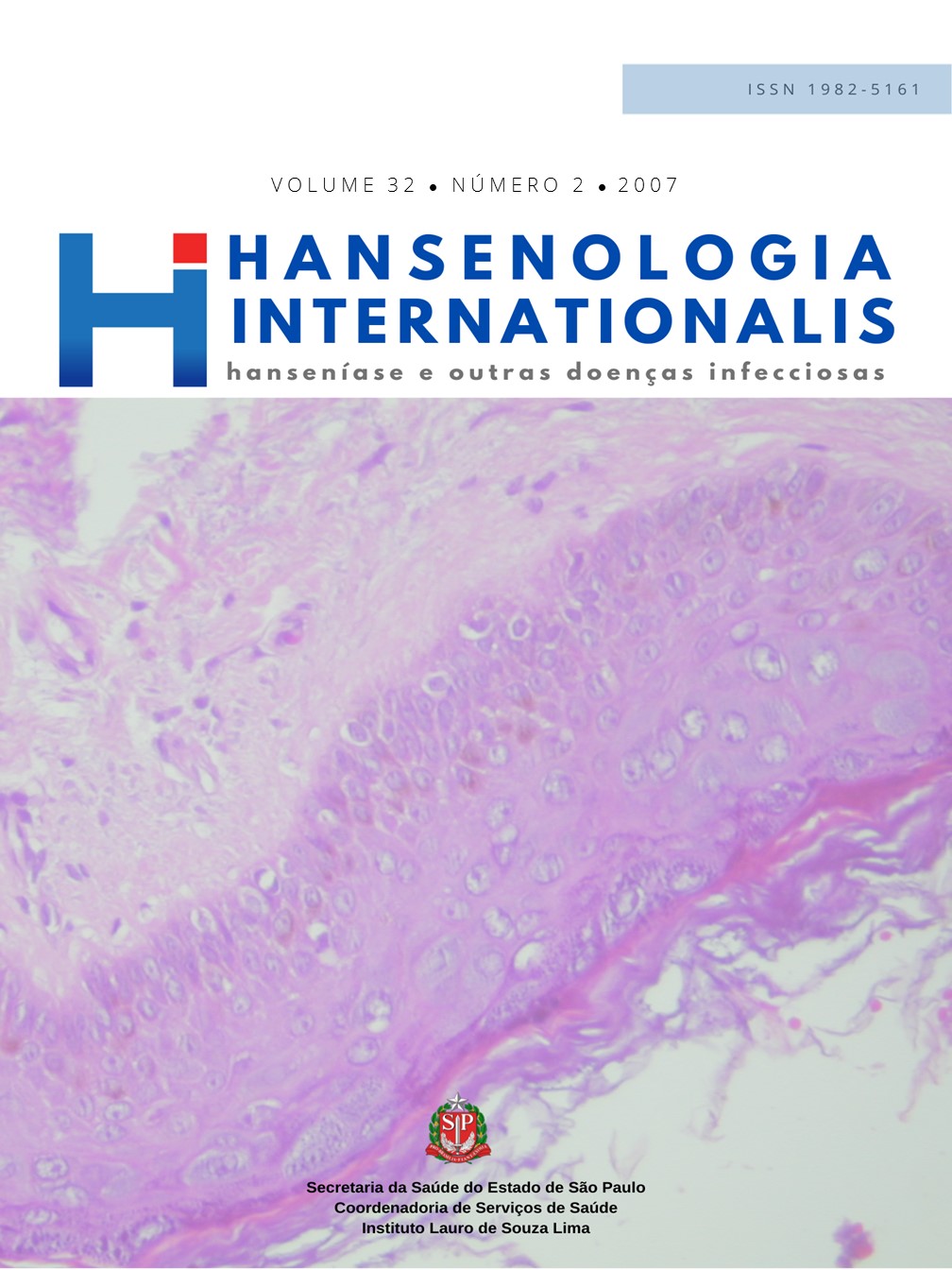Abstract
The treatment of leprosy is not limited to the cure of patient with leprosy bacilli, considering that the possible physical disabilities leprosy-induced are one of the most stigmatizing factors. With the changing of arrangement in the multi-drug therapy, from 24 to 12 doses, the need to get a better knowledge of how these patients have been behaving, when the drugs are out, regarding physical disabilities and (side effects reactions) outbreaks reaction. This is a cross-sectional study, to verify the degreesof physical disabilities in hands and feet, after high drug therapy from 1998 to 2000 being reevaluated in 2005. We evaluated 60 patients where 30 patients were treated with 12 doses and 30 patients were treated with 24 doses of three reference leprosy treatment centers in Plano Piloto - Brasilia. The presence of disabilities is related to the number of outbreaks reaction (side effects reactions).The Patients that were treated with 12 doses tended to produce more post-treatment reactions (10%), while those treated with 24 doses had a higher rate of reactions during treatment. Concerning the degrees of disability there was a significant worsening of the patients in both groups, in the second evaluation. There is a need for a greater control of post-discharge patients because the majority of further damage from leprosy reactions occurs when the drug therapy is out where the disabilities can appear. It is suggested that the patients’ monitoring becomes monthly to evaluate the development of reaction episodes and to prevent the development of the same degree of disability.
References
2. Virmond M, Vieth H. Prevenção de Incapacidades na Hanseníase: uma analise critica. Medicina Ribeirão Preto jul/set 1997; 30(2): 358-63.
3. Ministério da Saúde (BR). Departamento Nacional de Saúde. Serviço Nacional de Lepra. Guia para controle da Lepra. Revista de Leprologia 1960 (28): 40-50.
4. Talhari S, Neves RG. Hanseníase. 3 ed. Manaus: Gráfica Tropical; 1997. 167p.
5. Ministério da Saúde. Manual de Prevenção de incapacidades. Brasília: Área Técnica de dermatologia sanitária; 2001.
6. Ministério da Saúde. Guia para Controle da Hanseníase. (Cadernos de Atenção Básica,10). Brasília: Ministério da Saúde; 2002.
7. Cunha MGS, Rebello PB, Pennini SN, Sadahiro M, Scettini PM. Estados reacionais na hanseniase pós tratamento poliquimioterápico. Hansenologia Internacionalis 1997; 22(1): 115.
8. Chopra NK, Agrawal JS. Hansen’s disease deformities: na epidemiological study in a multidrog therapy Project Baroda District. The Star 1990; may/june: 9-12.
9. Trindade MAB, Nemes MI. Incapacidades físicas em hanseníase no momento do diagnóstico: características epidemiológicas dos casos registrados de 1983 a 1988 no estado de São Paulo. Hansen. Int. 1992; 17(1/2): 8-14.
10. Borges E, Gallo MEN, Alvim MFS, Bittencourt E. Determinação do grau de incapacidade em hansenianos não tratados. Cadernos de Saúde Pública 1987; 3(3): 266-71.
11. Opromolla DVA. Noções de Hansenologia. Bauru: Centro de Estudos “Dr. Reynaldo Quagliato”; 2000.
12. Diffey B, Vaz M, Soares MJ, Jacob AJW, Piers LS. The effect os leprosy-induced deformity on the nutritional status of index cases and their household members in rural South India: a socio-economic perspective. European Jounal of Clinical Nutritional 2000; (54): 643- 9.
13. Oh SY, Paik HJD. Dietary habits, food intake and funcional outcomes in those with a history of Hansen’s disease in Korea. International Jornal of Leprosy; 1998 66(1): 34 – 42.
14. Garbino JA. Manejo clínico das diferentes formas de comprometimento da neuropatia hanseniana. Hansen. Int. Special 1998.
15. Nery JAC, Garcia CC, Wanzeller SHO. Características clínico-histopatológicas dos estados reacionais na Hanseníase em pacientes submetidos à poliquimioterapia (PQT). Anais Bras. Dermatol; 1999 74(1): 27-33.
16. Carvalho GA. Incapacidades físicas de mão e pés em pacientes com hanseníase após PQT atendidos no Plano Piloto de Brasília. [Tese de doutorado]. Brasília: Faculdade de Ciência da Saúde da Universidade de Brasília; 2003.
17. Miranda MBS. Reações hansênicas em pacientes submetidos aos esquemas poliquimioterápicos de 12 e 24 doses no Distrito Federal (Brasil). [Dissertação de mestrado]. Brasília: Universidade de Brasília; 2005.
18. Oliveira MLW, Gomes MK, Pimentel MI, Castro MCRC. Reação reversa macular pós-alta de poliquimioterapia multibacilar. Hansen. Int. 1996; 21(1): 46-51.
19. Rodrigues ALP, Almeida AP, Rodrigues BF. Ocorrência de reações em pacientes pós-alta por cura de Hanseníase: subsídios para implementação de um programa de atenção específica. Hansen. Int. 2000; 25(1): 7-16.
20. Gallo MEN, Alvim MFS, Nery JAC, Albuquerque ECA. Estudo Comparativo com dois esquemas poliquimioterápicos (duração fixa) em hanseníase multibacilar. Hansen. Int. 1997; 22(1): 5-14.
21. Teo SK, Resztak KE, Scheffler M A. Thalidomide in the treatment of leprosy. Microbes and Infection. 2002; (4): 1193-1202.
22. Moreira D, Alvares RR. Utilização dos monofilamentos de Semmes - Weisntein na avaliação de sensibilidade dos membros superiores de pacientes hansenianos atendidos no Distrito Federal [Dissertação de Mestrado]. Brasília: Universidade de Brasília; 1999.
23. Pedroso M, Suery O, Bacarrelli R, Vieira PCT, Gonçalves A. Incapacidades físicas em hanseníase – estudo multicëntrico da realidade brasileira. Anais Brasileiros de dermatologia 1989; 64(6): 301-6.
24. Boggild AK, Keystone JS, Kain K. Leprosy: a primer for cana dian physicians CMAJ 2004; 170 (1).
25. Pimentel MIF, Nery JAC, Borges E. Neurite silenciosa na hanseníase multibacilar avaliada através da evolução das incapacidades antes, durante e após a poliquimioterapia. Anais Bras Dermatol 2004; 79 (2): 169-79.
26. Croft RP, Nicholls PG, Steyerberg EW, Richardus JH, Withington SG. A clinical prediction rule for function impairment in leprosy patints – revisited after 5 years of follow-up. Leprosy Review 2003; (74): 35-41.
27. Sauderson P. The epidemiology of reactions and nerve damage. Leprosy review 2000; 71 (3): 363-8.
28. Organização Pan-Americana da Saúde. Plano nacional de reabilitação física em hanseníase. Disponível em: http://www.opas.org.br.
29. Oliveira MHP. Associação entre atividades ocupacionais dos hansenianos e incapacidades físicas. R. Bras. Enferm. 1993; 46(3/4): 279-85.
30. Koelewijn FF, Meima A, Broekhuis SM, Richardus JH. Sensory testing in leprosy: comparison of ballpoint pen and monofilaments. Leprosy Review 2003; (74): 42-52.

This work is licensed under a Creative Commons Attribution 4.0 International License.
